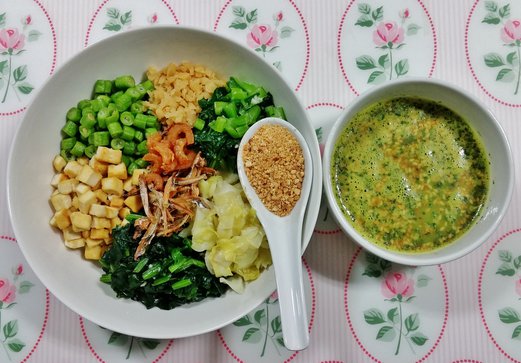Summary | Excerpt | Reviews | Beyond the Book | Read-Alikes | Genres & Themes | Author Bio

A Memoir with Recipes
by Carolyn PhillipsThis article relates to At the Chinese Table
 The Hakka are an ethnic minority of Han Chinese people who migrated out of the northern regions of China in waves taking place in the fourth and ninth centuries. Today, the largest populations of Hakka live in China's Guangdong Province (located in the southeast of China, near Hong Kong), and they have their own distinct language and culture. The name "Hakka" means "guest people" in Mandarin, presumed to be a reference to this group's nomadic history. Much of Carolyn Phillips' memoir At the Chinese Table takes place in Taiwan, and the family of the man she marries is Hakka. She learns to cook traditional Hakka cuisine in part to gain the approval of her in-laws.
The Hakka are an ethnic minority of Han Chinese people who migrated out of the northern regions of China in waves taking place in the fourth and ninth centuries. Today, the largest populations of Hakka live in China's Guangdong Province (located in the southeast of China, near Hong Kong), and they have their own distinct language and culture. The name "Hakka" means "guest people" in Mandarin, presumed to be a reference to this group's nomadic history. Much of Carolyn Phillips' memoir At the Chinese Table takes place in Taiwan, and the family of the man she marries is Hakka. She learns to cook traditional Hakka cuisine in part to gain the approval of her in-laws.
Since the Hakka have a history of migration through mountainous areas and sustained themselves largely through farming, their traditional foods tend to be dense and filling. Common ingredients include rice, pork, tofu and soy sauce. Ingredients like rice wine and salt ensured foods could be preserved and eaten later.
One popular Hakka dish is stewed pork belly (梅干扣肉). The pork belly is pan-fried and then stewed, then covered in a sugar and soy sauce concoction and served with rice and fermented vegetables. Another is stuffed tofu (釀豆腐) containing pork or shrimp, which can be fried or boiled. Kumquats are readily available in many of the regions the Hakka live or have lived, so baked chicken with kumquat sauce (客家油鸡) is also a popular meal.
Poon choy (盆菜) is a dish of three layers that is prepared with the cheapest ingredients — such as radishes and tofu — on the bottom and the most expensive ingredients — like shrimp and pork — on the top. It's generally meant to serve a group, making it a popular dish for New Year celebrations and other special occasions.
 Ground or pounded tea (Le cha - 擂茶) is a popular Hakka drink, with a preparation technique that goes back 2,000 years. Recipes vary, but it generally contains green tea, salt, ground mint leaves, sesame seeds and nuts. The tea is often served at the end of a meal, with all of the ingredients set out in bowls along with hot water so that each person can prepare their own tea exactly how they like it.
Ground or pounded tea (Le cha - 擂茶) is a popular Hakka drink, with a preparation technique that goes back 2,000 years. Recipes vary, but it generally contains green tea, salt, ground mint leaves, sesame seeds and nuts. The tea is often served at the end of a meal, with all of the ingredients set out in bowls along with hot water so that each person can prepare their own tea exactly how they like it.
Hakka restaurants are popular throughout south and eastern Asia, including in India, where the cuisine has been adapted to include traditionally Indian spices. One of the most popular dishes of the Hakka-Indian fusion cuisine is Hakka chili chicken, which contains fried chicken, onions, chili pepper, garlic, soy sauce, and Shaoxing cooking wine, among other ingredients.
Poon choy, courtesy of What2SeeOnline
Hakka pounded tea, courtesy of Spring Tomorrow
Filed under Places, Cultures & Identities
![]() This article relates to At the Chinese Table.
It first ran in the August 18, 2021
issue of BookBrowse Recommends.
This article relates to At the Chinese Table.
It first ran in the August 18, 2021
issue of BookBrowse Recommends.
The whole problem with the world is that fools and fanatics are always so certain of themselves, and wiser people ...
Click Here to find out who said this, as well as discovering other famous literary quotes!
Your guide toexceptional books
BookBrowse seeks out and recommends the best in contemporary fiction and nonfiction—books that not only engage and entertain but also deepen our understanding of ourselves and the world around us.